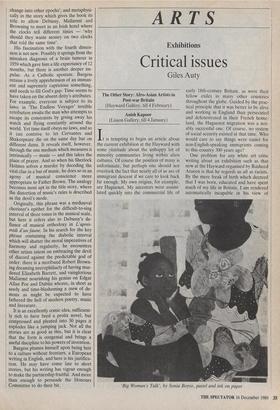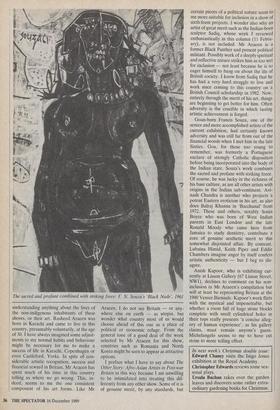ARTS
Exhibitions
Critical issues
Giles Auty
The Other Story: Afro-Asian Artists in Post-war Britain (Hayward Gallery, till 4 February) Anish Kapoor (Lisson Gallery, till 4 January)
It is tempting to begin an article about the current exhibition at the Hayward with some platitude about the unhappy lot of minority communities living within alien cultures. Of course the position of many is unfortunate, but perhaps one should not overlook the fact that nearly all of us are of immigrant descent if we care to look back far enough. My own origins, for example, are Huguenot. My ancestors were assimi- lated quickly into the commercial life of early 18th-century Britain, as were their fellow exiles in many other countries throughout the globe. Guided by the prac- tical principle that it was better to be alive and working in England than persecuted and defenestrated in their French home- land, the Huguenot migration was a not- ably successful one. Of course, no system of social security existed at that time. Who would care to say things were easier for non-English-speaking immigrants coming to this country 300 years ago?
One problem for any white art critic writing about an exhibition such as that now at the Hayward organised by Rasheed Araeen is that he regards us all as racists. By the mere freak of birth which decreed that I was born, educated and have spent much of my life in Britain, I am rendered automatically incapable in his view of 'Big Woman's Talk', by Sonic, Rowe, pastel and ink on paper The sacred and profane combined with striking force: F. N. Souza's 'Black Nude', 1961 understanding anything about the lives of the non-indigenous inhabitants of these shores, or their art. Rasheed Araeen was born in Karachi and came to live in this country, presumably voluntarily, at the age of 30. I have always imagined some adjust- ments to my normal habits and behaviour might be necessary for me to make a success of life in Karachi, Copenhagen or even Castleford, Yorks. In spite of con- siderable artistic recognition, success and financial reward in Britain, Mr Araeen has spent much of his time in this country telling us where we go wrong. This, in- deed, seems to me the one consistent component of his art forms. Like Mr Araeen, I do not see Britain — or any- where else on earth — as utopia, but wonder what country most of us would choose ahead of this one as a place of political or economic refuge. From the general tone of a good deal of the work selected by Mr Araeen for this show, countries such as Romania and North Korea might be seen to appear as attractive options.
I preface what I have to say about The Other Story: Afro-Asian Artists in Post-war Britain in this way because I am unwilling to be intimidated into treating this dif- ferently from any other show. Some of it is of genuine merit, by any standards, but
certain pieces of a political nature seem to me more suitable for inclusion in a show of sixth-form projects. I wonder also why an artist of great merit such as the Indian-born sculptor Sadiq, whose work I reviewed enthusiastically in this column (11 Febru- ary), is not included. Mr Araeen is a former Black Panther and present political militant. Possibly work of a deeply spiritual and reflective nature strikes him as too wet for inclusion — not least because he is so eager himself to bang on about the ills of British society. I know from Sadiq that he has had a very hard struggle to live and work since coming to this country on a British Council scholarship in 1982, Now, entirely through the merit of his art, things are beginning to get better for him. Often adversity is the crucible in which lasting artistic achievement is forged.
Goan-born Francis Souza, one of the senior and more accomplished artists of the current exhibition, had certainly known adversity and was still far from out of the financial woods when I met him in the late Sixties. Goa, for those too young to remember, was formerly a Portuguese enclave of strongly Catholic disposition before being incorporated into the body of the Indian state. Souza's work combines the sacred and profane with striking force. Of course, he was lucky in the richness of his base culture, as are all other artists with origins in the Indian sub-continent. Avi- nash Chandra is another who projects a potent Eastern eroticism in his art, as also does Balraj Khanna in 'Bacchanal' from 1972. These and others, notably Sonia Boyce who was born of West Indian parents in East London and the late Ronald Moody who came here from Jamaica to study dentistry, contribute a core of genuine aesthetic merit to this somewhat disjointed affair. By contrast, Lubaina Himid, Keith Piper and Eddie Chambers imagine anger by itself confers artistic authenticity — but I beg to dis- agree, Anish Kapoor, who is exhibiting cur- rently at Lisson Gallery (67 Lisson Street, NW1), declines to comment on his non- inclusion in Mr Araeen's compilation but will at least be representing Britain at the 1990 Venice Biennale. Kapoor's work flirts with the mystical and impenetrable, but whether a room full of huge stone blocks complete with small cylindrical holes in their tops really presents 'a concise alleg- ory of human experience', as his gallery claims, must remain anyone's guess. Michelangelo seems to me to have cut stone to more telling effect.



















































 Previous page
Previous page